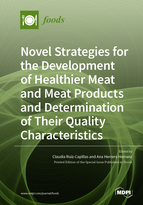Novel Strategies for the Development of Healthier Meat and Meat Products and Determination of Their Quality Characteristics
A special issue of Foods (ISSN 2304-8158). This special issue belongs to the section "Meat".
Deadline for manuscript submissions: closed (25 October 2020) | Viewed by 49241
Special Issue Editors
Interests: meat quality; food safety; animal production; food analysis; meat science; poultry; animal nutrition; food microbiology and safety; food science and technology; food preservation
Special Issues, Collections and Topics in MDPI journals
Interests: development of healthy meat products; vibrational spectroscopic techniques (raman and infrared spectroscopy); textural properties; biogenic amines; food safety; quality indices
Special Issues, Collections and Topics in MDPI journals
Special Issue Information
Dear Colleagues,
Meat and meat products are an important group of nutritionally rich foods which are very popular and widely accepted. However, their consumption can have some negative consequences on health due to some of their components, such as lipids, salt, and additives, among others. This has led to the consumer perception of meat products as being less attractive. There is also a clear link between nutrition and human health, with the latter increasingly becoming a quality criterion for consumers when choosing the type of food they consume. Today, there are new trends and innovations in the design of healthy food, particularly meat products with specific characteristics. Recent advances have been reported in the design and development of new strategies for the production of healthy meat products, based mainly on the removal of unhealthy components and their replacement with a healthy alternative. Reformulation strategies are the most common procedures used in designing new healthy meat products because they represent the fastest way to modify the composition of the final product. These procedures are an option to improve the image of meat and meat products, meet the needs of consumers, and influence and improve bodily functions while still meeting basic nutritional needs. These reformulation strategies must, however, result in products whose quality characteristics are similar to those of the original meat product. Our aim here is to gather all the new information in this field and include it in the Special Issue on “Novel Strategies for the Development of Healthier Meat and Meat Products and Determination of Their Quality Characteristics”. We invite researchers to contribute original and unpublished research and review articles on this topic.
Dr. Claudia Ruiz-Capillas
Dr. Ana Herrero Herranz
Guest Editors
Manuscript Submission Information
Manuscripts should be submitted online at www.mdpi.com by registering and logging in to this website. Once you are registered, click here to go to the submission form. Manuscripts can be submitted until the deadline. All submissions that pass pre-check are peer-reviewed. Accepted papers will be published continuously in the journal (as soon as accepted) and will be listed together on the special issue website. Research articles, review articles as well as short communications are invited. For planned papers, a title and short abstract (about 100 words) can be sent to the Editorial Office for announcement on this website.
Submitted manuscripts should not have been published previously, nor be under consideration for publication elsewhere (except conference proceedings papers). All manuscripts are thoroughly refereed through a single-blind peer-review process. A guide for authors and other relevant information for submission of manuscripts is available on the Instructions for Authors page. Foods is an international peer-reviewed open access semimonthly journal published by MDPI.
Please visit the Instructions for Authors page before submitting a manuscript. The Article Processing Charge (APC) for publication in this open access journal is 2900 CHF (Swiss Francs). Submitted papers should be well formatted and use good English. Authors may use MDPI's English editing service prior to publication or during author revisions.
Keywords
- Meat and meat products
- Development of healthy meat products
- Functional food
- Digestion of food
- Processing
- Storage
- Oil-structuring methods
- Unhealthy compounds (fat, cholesterol, salt, nitrites, etc.)
- Healthy ingredients (vegetable protein, fiber, antioxidants, nuts, seaweed, vegetable and marine oils, etc.)
- Additives
- Physicochemical properties
- Microbiological properties
- Structural characteristics







